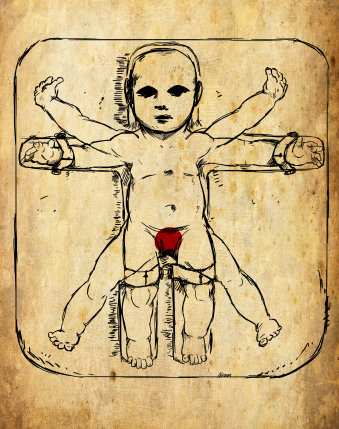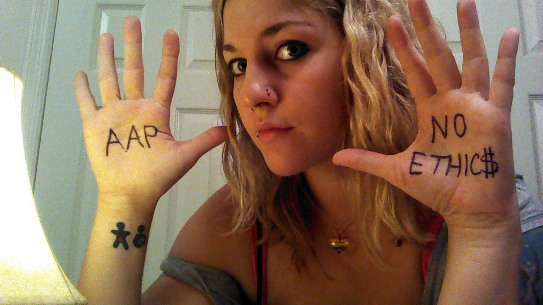By Joel Smart (The Cascade) – Email
Print Edition: September 12, 2012
You’re restrained. Held down. Cut. Your screams are ignored. You aren’t told why it’s happening or if it will ever stop. Long after you’ve given up hope that you’ll ever be held and comforted again, you are assured that, no, this wasn’t a violation. It was for your own good.
Would that make it okay? Would it be okay if you didn’t remember the experience several years into the future? These are the serious considerations that must be taken into account when we discuss the subject of infant genital cutting – while few actively remember it, the trauma that many children are forced to go through is very real.
Now, consider what your position would be if a medical organization declared that we should tie down our baby girls and cut off some of the most densely innervated genital tissue on their body. What if they said that the risks of performing the operation weren’t that great if performed by trained physicians? In fact, the American Academy of Pediatrics (AAP) made a statement similar to this in 2010, when they argued that female genital cutting should be made legal in America, so that physicians could “prick” or “incise” the “clitoral skin to satisfy cultural requirements.” They hoped to appease religious groups that believe in the practice. It was a position they quickly retracted when human rights activists condemned the policy, suggesting it violated the child’s right to bodily integrity – a human right that all people are born with and guaranteed under the law.
Would we tolerate female genital cutting if the same group came out and said that the practice had some minor health benefits? Perhaps fewer urinary tract infections for baby girls in the first year of life? What if cutting off a girl’s clitoral hood and her inner labia might reduce her chance of acquiring HIV if she slept with an infected partner without a condom on?
I don’t think we’d accept that rationale. I don’t think we’d say those reasons were greater than the harm done by holding a baby down and cutting off a part of their body without their consent. However, the AAP made just such a statement on August 27. They argued that the benefits of genital cutting outweighed the risks; the only difference is that they were talking about boys, not girls.
Once again, the critics are arguing that the statement fails to consider the child’s right to bodily integrity – the right to make choices about your own healthy, sensitive, functional body parts, or to have that right preserved until you’re old enough to decide. Among the critics is Canada’s advocacy group The Children’s Health and Human Rights Partnership, which condemned the AAP’s new policy and encourages the Canadian Paediatric Society to maintain its current stance against circumcising healthy infants.
The foreskin, which is removed during a circumcision, is the most sensitive part of the penis to fine-touch, according to Sorrells (2007) and has unique nerve endings much like those found in the fingertips and lips, according to Taylor (1996). Yet, the AAP argues that circumcision doesn’t “appear to adversely affect penile sexual function/sensitivity or sexual satisfaction.” One need only ask a man with a foreskin whether it has any sensitivity to know that cutting it off would reduce what he could feel. In contrast, the Royal Dutch Medical Association explains that “the foreskin is a complex erotogenic structure that plays an important role in the mechanical function of the penis during sexual acts.”
Regardless, the AAP can hardly argue that the benefits of circumcision outweigh the risks, because they themselves admit in their statement that the true complication rate of circumcision is unknown. So, you should be asking at this point, why would they make a conclusion that they admit they can’t say for sure?
Brian Earp, who writes Practical Ethics for the University of Oxford, suggests that at least part of the answer comes by following the money. “The AAP is not a dispassionate scientific research body, but rather a trade association for pediatricians,” he explains, “Those among its members and stakeholders who perform [circumcisions] stand to profit from the procedure, to the collective annual tune of $1.25 billion.” While the point isn’t that the statement is entirely driven by profit, it’s undeniable that money is a motivating factor; the AAP explicitly requested circumcision funding from medical insurance companies. Currently circumcision is classified as “cosmetic surgery” due to the fact that it is unnecessary and removes normal, healthy tissue.
Chris Booker, a researcher at the Centre for Neuroendocrinology at the University of Otago, had his critique published alongside the updated statement. He and Earp both challenge many of the assertions of the taskforce, explaining that studies done in Africa testing HIV-acquisition of heterosexual men were methodologically flawed, and that even if they weren’t, they couldn’t be transferred to an American population where the HIV rates are lower, come from different types of behaviours, and are otherwise not related to the situation in Africa – a problem that the AAP statement acknowledges, but goes on to do anyway. For Earp it’s simple: “Bad science + bad ethics = bad medicine.”
It’s an issue that provokes strong, emotional reactions on both sides of the coin. Those who wish to have their children’s genitals cut feel oppressed by Germany’s recent ruling that declared infant male circumcision illegal, while human rights activists believe the AAP has put their pediatricians’ interests ahead of their duty to “first, do no harm.”
There is no simple way to get everyone on the same page, but when in doubt, shouldn’t we let the individual make the choice for their own body? After all, it is the individual who will live with the consequences, good or bad, for the rest of their lives.



